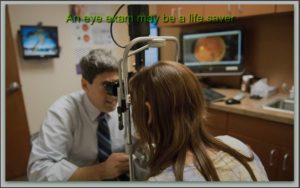
While your eyes may be the window to your soul, in my practice Eye Surgeons and Consultants, they are a door, wide open with the opportunity to the diagnosis of hundreds of systemic diseases.
Here are nine of the most common we see on a daily basis.
#1 Diabetes
Diabetes is one of the most common illnesses that can be identified on routine eye screenings. I cannot even count the number of times a patient has come in for a routine eye exam and walked out with a recommendation to see an endocrinologist for a possible diabetes diagnosis.
Diabetes is a disease that affects blood vessels throughout the body, primarily in your eyes and kidneys. Blood vessels in your retina are especially predisposed to leaking blood or fluid, providing a “red flag” that can be readily seen on eye examination and signal to eye doctors that a patient likely has systemic diabetes and requires further testing and treatment.
I mentioned Diabetes first since November is National Diabetes Awareness Month, a time for professionals to recommend small changes which can make a big impact as well as make the public mindful of the widespread pervasiveness of this disease.
‘One in 10 Americans have diabetes — that’s more than 30 million people. And another 84 million adults in the United States are at high risk of developing type 2 diabetes.’
#2 Graves’ Disease
The diagnostic ability of your ophthalmologist is not limited to diabetes. Thyroid diseases such as Graves’ Disease are often diagnosed when patients experience exophthalmos, a swelling of the eyeball that can sometimes protrude out of the eye socket.
Identifying thyroid diseases early can not only save your vision, but can also save your life.
#3, #4 #5 Rheumatoid arthritis, lupus, and multiple sclerosis (MS)
While that may sound melodramatic, the eye is sometimes one of the first organs affected by autoimmune conditions such as Rheumatoid Arthritis, Lupus, and Multiple Sclerosis (MS) with patient symptoms ranging from temporary blindness to simple redness of the eye. In MS, in particular, up to 20% of patients initially complain of sudden vision loss in only one eye, pain with eye movement, or double vision before walking out with a recommendation to see a specialist.
#6 Lyme Disease
Aside from pink eye, which is probably one of the most common reasons to visit your ophthalmologist, many infectious diseases are often diagnosed at the eye doctor’s office, including Lyme Disease, Adenovirus, TB, Herpes viruses, syphilis, and even HIV. While some of these diseases, such as adenovirus, often resolve quickly and easily, others can cause permanent damage if not treated quickly. Ensuring patients are immediately started on appropriate antibiotics and or other antimicrobial treatments often protects not only patients, but also family members and close contacts, preventing wide-spread outbreaks of these diseases.
#7 Sickle-Cell Anemia
Speaking of family members, ophthalmologists frequently diagnose illnesses in babies and children.
In children, eye doctors may be the first to find evidence of chronic illnesses such as sickle-cell anemia, retinoblastoma, or juvenile arthritis, infectious illnesses such as CMV, rubella, or congenital syphilis and even signs of trauma or abuse, such as evidence of shaken-baby syndrome.
These early warning signs allow doctors to intervene quickly and save patient lives.
#8 Preeclampsia
In pregnant women, preeclampsia can cause high blood pressure which appears on routine eye exams as “nicked”- appearing blood vessels. Without treatment, preeclampsia can cause miscarriage, premature birth, and placental anomalies for the baby as well as seizures and other severe side effects in the mom.
Caught early, these terrible consequences of preeclampsia can often be completely avoided.
#9 Metastatic Breast Cancer
Perhaps even more surprisingly, eye physicians can diagnose cancers on routine eye exams. Often, women may be completely asymptomatic, but have severe, metastatic breast cancer. Ophthalmologists may see metastases, or tumors that have grown beyond the original tumor’s location, in the choroid, located behind the retina.
Once a tumor is found, we can rapidly refer patients to an oncologist for immediate treatment. Other systemic cancers, including colon cancer, lung cancer, kidney cancer, brain cancer and even melanoma can often be first diagnosed on routine eye exams.
While most patients walk out of our office with a new prescription for glasses, there are times our prescriptions can give you a new lease on life…
For the price of your annual appointment.
